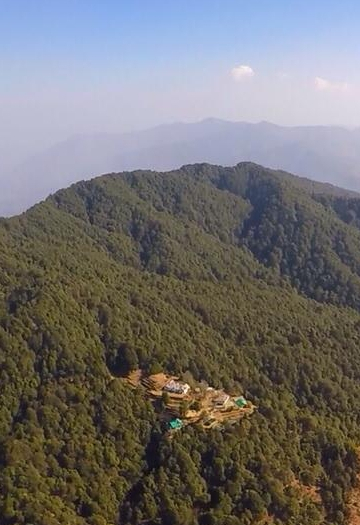Binsar is a protected wildlife area comprising oak, rhododendron and pine forests on a mountain rising up to 8000 ft. It is situated 30 kilometres north east of Almora in the Kumaon region of the state of Uttarakhand in North India.
Binsar Myths
Binsar is a British distortion of Veeneshwar, one of the many names given to Lord Shiva. The eponymous Veeneshwar / Binsar Mahadev temple sits at the centre of a mystical cross, with important Shiva and Devi temples exactly 14 kilometres in the four cardinal directions. The locals venerate this temple, which also has the power to bring rain. The legendary Saptarshis have meditated here too. And the local deity, Dana Golu, is also said to have resided in these forests. In addition to protecting the forest’s denizens, Dana Golu appears as white horseman and guides lost people. Gerar, in the lower reaches of the Sanctuary, has a beautiful Golu devta temple.
History of Binsar
Binsar used to be the hunting grounds of the old Chand rulers of Almora. In later years, after the British defeated Nepal and Kumaon became a British administered region, the senior bureaucrats of the administration established estates here. Consequently, they protected the region from pine plantation (the fate of large parts of Kumoan, including the lower reaches of the present day Sanctuary). They also grew orchards in the estates and made it their summer home, their own Shimla. After independence, the estates continued to grow fruits until the final years of the 20th century, after which most estates shifted focus from growing fruit to welcoming travellers.
See Amitabh Dhillon’s article on the history of Binsar.
Animals in Binsar
Binsar has a wide variety of wildlife – leopards, mountain goats, barking deer, wild boars, porcupines, yellow-throated martens, himalayan palm civets, hares, serows, and the ubiquitous langurs and macaques.
Birds in Binsar
The upper part of the sanctuary is a dense oak forest and cool while the lower part is a pine forest and relatively warmer. Additionally, the lower part of the sanctuary is inhabited by villages. These factors create diverse environments and support different bird species.
Spring is usually a great time for birds here. In addition to year-round bird species like jays, tits, nuthatches, sibias, thrushes, warblers and doves, many migrants arrive for nesting – Flycatchers (verditers arrive from western ghats) and bulbuls. The hills come alive with bird song as soon as the sun rises and the birds awake. Hill partridges and various kinds of pheasants are also quite commonly seen.
Higher Himalayan views from Binsar
Binsar offers stunning views of the chain of Himalayan peaks from Yamunotri in Garhwal to Mt. Nampa in Nepal. Dominating this higher Himalayan range are the sacred peaks of Nanda Devi, Trishul and Nanda Kot. Also quite stunning are the sweeping views of the mountains and valleys of Kumaon as far as the eye can see.
Hiking in Binsar
Binsar Wildlife Sanctuary has over 60 km of hiking trails. Given the dense forest cover and spectacular views from these trails, walking is the best way to experience the Sanctuary. See here for the some of the hiking trails we have mapped.

You must be logged in to post a comment.